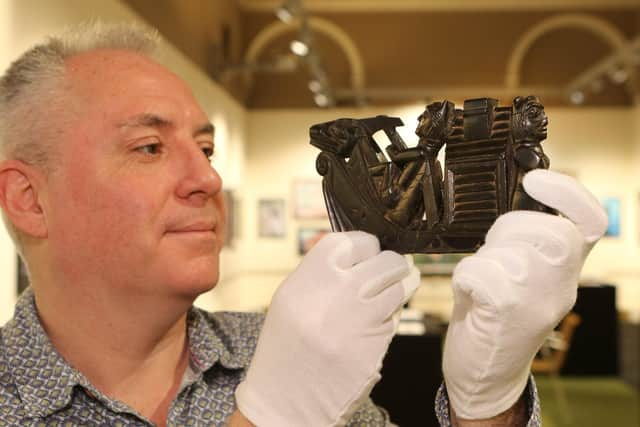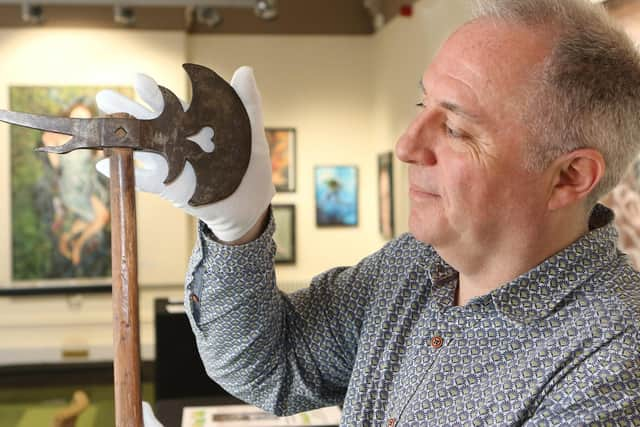Buxton Museum staff member wins fellowship to return indigenous artefacts to Canada and US
and live on Freeview channel 276
Buxton Museum and Art Gallery is the only institution in the country which is actively contacting indigenous communities to return their heritage artefacts from its collection, says the staff member who has won funding to make this project a reality.
Bret Gaunt, a curator at the museum, is about to embark on a year-long project which will see him research and exhibit the items before returning them to their communities in Canada and the United States.
Advertisement
Hide AdAdvertisement
Hide AdHe said: “I am delighted to have been awarded this funding.


"I never expected to be successful but I’m excited to take on this challenge.
"It’s definitely a once in a lifetime opportunity for me and for Buxton Museum and Art Gallery.”
There are 51 Native American and First Nations artefacts now in the museum on Buxton’s Terrace Road. They were previously part of the Derbyshire School Library Service.
Advertisement
Hide AdThe Derbyshire County Council run service was set up in 1936 to create collections of museum quality artefacts which were taken into schools for the pupils to see and learn about.


Advertisement
Hide AdAfter the closure of the service in 2018, the items were transferred to the museum.
In recent months, more than 2,000 items have found new homes in museums, galleries, archives, libraries, and trusts and foundations across this country and abroad.
Bret said the new work follows on from this project.
“We had these beautiful Native American and First Nations’ artefacts in the School Library Service collection, but they don’t really fit in with our collection which focuses on the history of the Peak District,” he added.
Advertisement
Hide Ad“We felt it would be best if we could return them to their rightful communities.”
Bret applied to the Headley Trust and Art Fund for a fellowship to do this work.
Advertisement
Hide AdThe Headley Trust and Art Fund was set up in 2018 to preserve and share curatorial skills and knowledge that are at risk in the face of current funding cuts. In October the fund announced that Bret was one of only ten museum curators to be awarded a fellowship.
A total of £302,500 has been awarded in this third round of the programme nationwide.
Advertisement
Hide AdBret has been researching the artefacts, finding out how they came into the collection and where they originally came from.
He has talked to curators at the National Museum of the American Indian at the Smithsonian Institute in Washington.
They confirmed his suspicion the items are nearly 200 years old and of exceptional quality.
Advertisement
Hide AdThe artefacts come from many indigenous communities. Bret has spoken with the Haida Gwaii Museum in British Columbia, and the Anishinabek First Nations Community in eastern Canada, who represent more than 130 communities living across the modern borders of Canada and the United States.
Advertisement
Hide AdBret said: “I have already contacted some First Nations communities.
"They told me that the work I am about to embark on is unprecedented and never been done before. Normally the indigenous communities have to fight tooth and nail to try and get their heritage returned.
“Some of these items are sacred and deeply personal, used in rituals to celebrate births, the naming of a child, their becoming an adult, weddings and deaths.
“Possibly these items were purposely removed during times of conflict in the 19th century.
Advertisement
Hide AdAdvertisement
Hide Ad“This was when Europeans settled in areas of the USA and Canada and contact with indigenous communities was not always peaceful.
“The colonial governments banned many ceremonies and traditional ways of life, even outlawing speaking their own languages.
“It’s like us being told we could never put a Christmas tree up, having them ripped out of homes and the special plates we save for Christmas dinner taken too with no real explanation.
“We’d be mad and we’d tell our children about it and there would be hurt and pain which would last for generations.
Advertisement
Hide Ad“That is what happened to the indigenous communities and it’s time to make a change and return what isn’t ours.”
Advertisement
Hide AdBret’s fellowship will start in February. He said: “This is a part of my job I have only touched on in the past.
“It will be interesting to expand my knowledge and learn about repatriation and restitution policies across the communities before the pieces are returned.”
There will be an exhibition of the objects at Buxton Museum before they are returned, and a community outreach project at Buxton Museum with a local artist.
Advertisement
Hide AdBret will meet colleagues in museums in the UK who are also working on decolonialisation of collections, and then undertake the study trip to North America to return this heritage to individual communities.